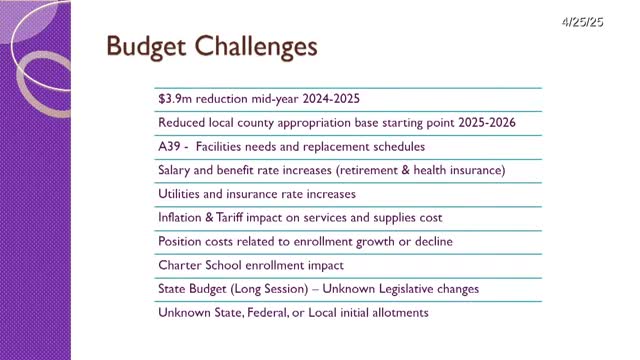Asheville City Schools details budget challenges and funding impacts from charter school enrollment
April 27, 2025 | Buncombe County Schools, School Districts, North Carolina
Thanks to Scribe from Workplace AI , all articles about North Carolina are free for you to enjoy throughout 2025!

This article was created by AI using a video recording of the meeting. It summarizes the key points discussed, but for full details and context, please refer to the video of the full meeting. Link to Full Meeting
As the board reviewed the budget, it became clear that the district is grappling with significant uncertainties stemming from state legislative changes. The state budget, which is typically finalized in December, remains unpredictable, with potential unfunded mandates that could impose additional costs on local schools. This situation is compounded by a decrease in average daily membership (ADM), which affects funding allocations. The district's ADM has only slightly declined, yet the state’s planning allotments have not aligned with expectations, primarily due to an increase in charter school enrollments.
The financial landscape is stark: state funding covers 56% of expenditures, while local sources contribute 33%, and federal funding accounts for just 8%. This year, the federal contribution has dropped significantly, reflecting the end of COVID-related funding programs. The board emphasized that local funding is crucial, especially for staffing needs that state and federal dollars do not adequately support.
A significant portion of the budget—84%—is allocated to salaries and benefits, underscoring the district's commitment to human capital. However, rising operational costs, including a staggering 78% increase in property insurance, have raised alarms. The board noted that these increases are not unique to Buncombe County but are part of a broader trend affecting schools nationwide.
The proposed budget for the 2025-2026 school year includes a request for an additional $10 million to maintain current services and address rising costs. This request reflects the district's ongoing efforts to align its budget with the needs of its students while navigating the constraints of state funding. The board members expressed a need for transparency with the public, stressing that the request for increased funding is not merely for surplus but essential for sustaining educational services amid rising operational costs.
As the meeting concluded, the board recognized the importance of community understanding regarding the financial pressures they face. With the state’s contribution to education funding declining over the years, the reliance on local dollars has become increasingly critical. The discussions at this budget work session set the stage for ongoing conversations about how to best support the educational needs of Buncombe County students in a challenging financial environment.
Converted from Buncombe County Schools Board of Education Special Called Meeting - 4/25/25 - Budget Work Session meeting on April 27, 2025
Link to Full Meeting
Comments
View full meeting
This article is based on a recent meeting—watch the full video and explore the complete transcript for deeper insights into the discussion.
View full meeting